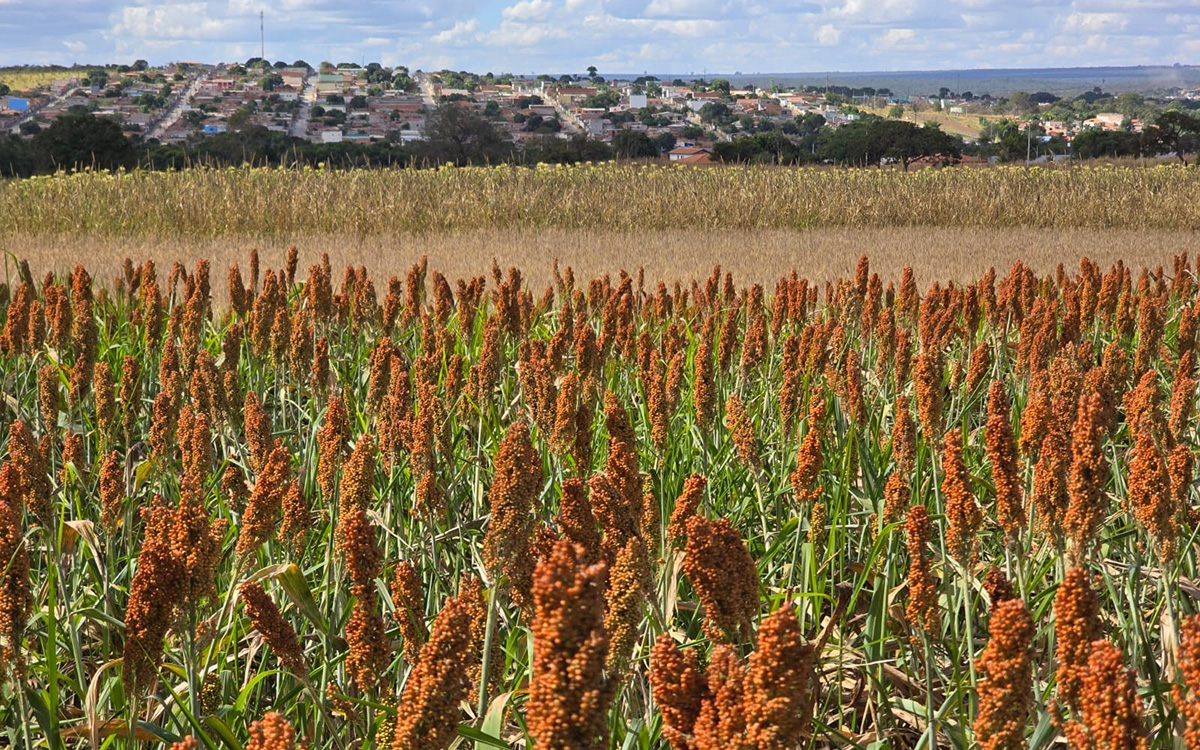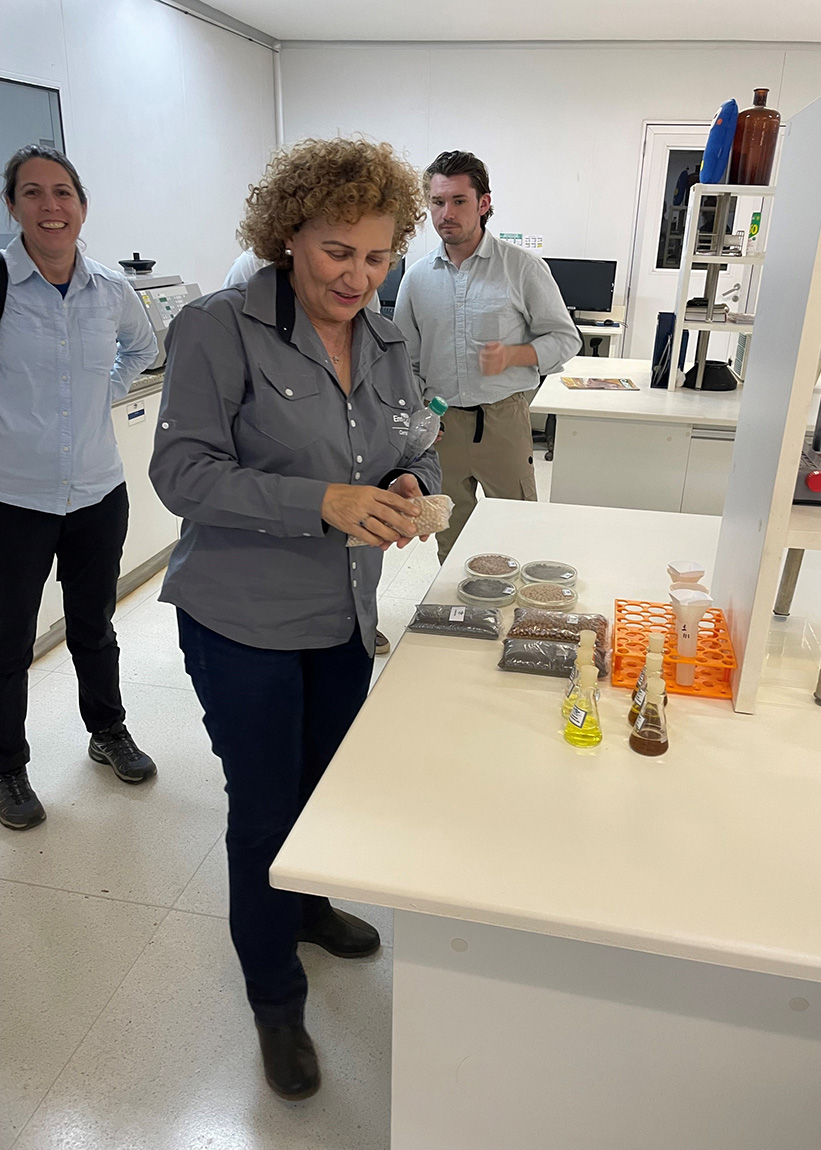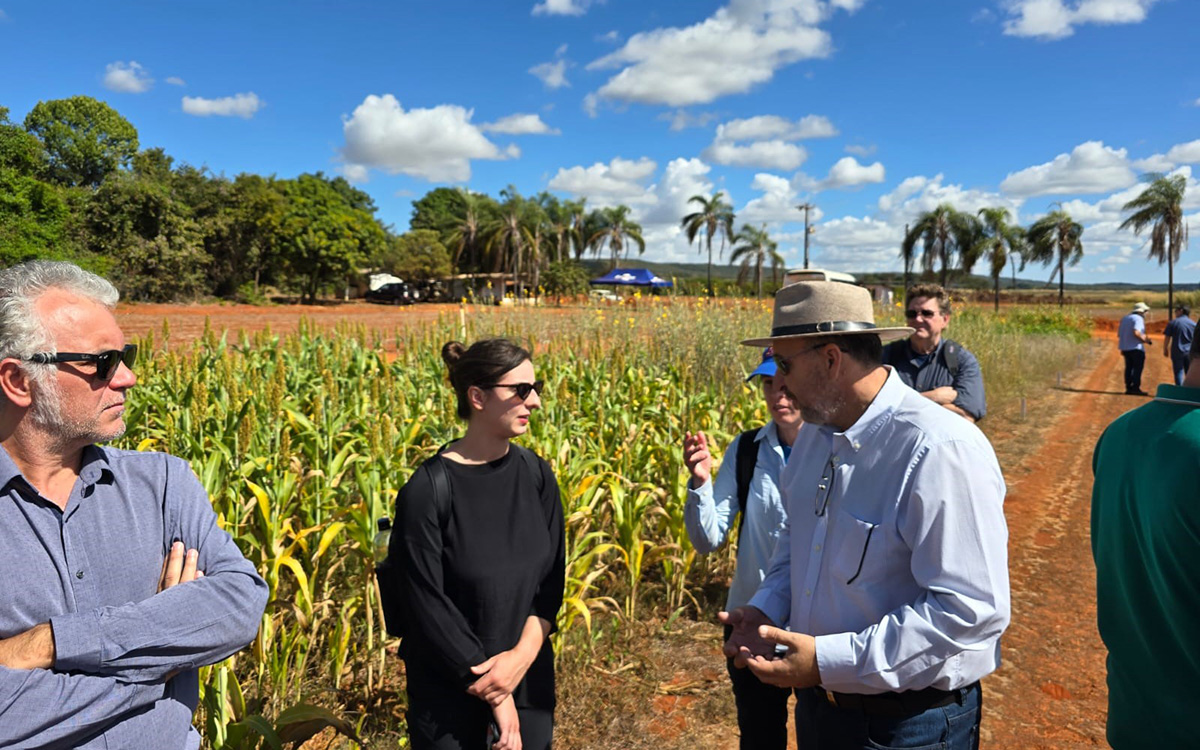Fertilizer Diplomacy
The ground under their feet shows diplomats the way to feed a growing planet.
BY MICHAEL CONLON

Sorghum fields grow in the Cerrado in eastern Brazil, June 2024.
Courtesy of Michael Conlon

Embrapa’s Dr. Ieda Mendes at her lab at Embrapa Cerrados in June 2024.
Courtesy of Michael Conlon
By 2050 there will be an estimated 2.5 billion additional people on the planet. To feed them all, we will need to produce 60 percent more food, yet climate change may hinder our ability to produce this food. We will need to feed the growing global population using more nutritious and climate-resilient crop varieties, less water, less agricultural land, and new agriculture technologies and innovations. One important piece of this challenge is already being addressed by diplomats in the United States and Brazil: developing fertilizers that are more effective and sustainable.
The U.S. and Brazil together feed around 25 percent of the world’s population. Without the two countries’ production, the world’s food supply would be critically low. Thus, it makes sense for these two agricultural powerhouses to team up to work for solutions to climate change and food insecurity. As world leaders in agricultural research, the United States and Brazil have made agricultural collaboration a cornerstone of their close relationship over the last several decades, and the work diplomats and scientists are doing now will pay dividends for the future.
At U.S. Embassy Brasília, partnering with Brazil on climate change and food insecurity solutions is a top priority. Brazil will host the Group of 20 (G20) in 2024 and the Conference of Parties (COP) 30 in 2025, giving this partnership a public face and, hopefully, leading to better understanding of the ways fertilizer advancements can make or break climate policy initiatives.
As Brazil prepares for the G20 and COP30, the embassy is promoting greater partnership through two major fertilizer initiatives with global implications: the Fertilize 4 Life (F4L) Initiative and the Vision for Adapted Crops and Soils (VACS).
A Major Climate Issue
Modern agricultural yields are made possible through fertilizers, which provide the nutrients plants need to grow and thrive. Since the advent of agriculture, perhaps as long as 8,000 years ago, farmers used traditional fertilizers such as manure and wood ash to improve soil fertility. In the 20th century, synthetic fertilizers made from chemical processes became a critical part of modern agriculture, dramatically increasing crop production to feed a growing world population.
Since the 1950s, however, there have been few advances in fertilizer technology, and synthetic fertilizers can wreak havoc on the natural environment due to the heavy carbon footprint of modern fertilizer production methods. Manufacturing of synthetic nitrogen fertilizer relies on natural gas, a nonrenewable source of energy that releases greenhouse gases (GHGs) into the environment.
Fertilizers also produce GHGs after farmers apply them to their fields. Much of the applied fertilizer runs into waterways or is broken down by soil microbes, releasing nitrous oxide into the atmosphere. Pound for pound, nitrous oxide warms the planet 300 times more than carbon dioxide. And in recent years in Brazil, farmers have been forced to use more and more fertilizers to maintain current yields—Brazilian soils typically have low fertility compared to U.S. soils, leading to higher application rates.
The difficult task of improving fertilizer-use efficiency is critical. As Dr. Luke Ney, director of development assistance at USDA Foreign Agricultural Service (FAS) and administrator of the F4L Initiative, has emphasized: “Reducing overuse of synthetic fertilizers is key to keeping agriculture sustainable, both for controlling input costs to farmers and creating a healthier planet.”
U.S.-Brazil Collaboration: A Brief History
Until the 1970s, Brazil had to import most of its food. But in less than 30 years, it has transformed itself into an agricultural powerhouse, going from a net food importer to a major exporter of agricultural products. Known as Brazil’s Green Revolution, this tremendous increase in agricultural production is widely considered one of the most important global developments in the second half of the 20th century. Today, Brazil is among the top five producers of 36 agricultural products and the leading exporter of soybeans, corn, coffee, sugar, beef, poultry, and orange juice.
The United States played a vital role in Brazil’s agricultural development. In 1920 Peter Henry Rolfs, the former dean of the College of Agriculture at the University of Florida, helped to create the Federal University of Vicosa, today one of Brazil’s premier agricultural universities. Nelson Rockefeller provided technical assistance to Brazil in agriculture during his time as a federal government employee—including as assistant secretary of State for Latin American affairs in the 1940s—creating several organizations that continue to assist Brazil today.
Reducing overuse of synthetic fertilizers is key to keeping agriculture sustainable, both for controlling input costs to farmers and creating a healthier planet.
In 1973 the U.S. Agency for International Development (USAID) played an essential role in creating the Brazilian Agricultural Research Corporation (Embrapa), a main driver of Brazil’s agricultural revolution and widely considered one of the world’s leading research centers on tropical agriculture, which aims to improve agricultural productivity through applied research and technology transfer to farmers.
USAID funded the construction of Brazilian laboratories and research centers and sponsored hundreds of young Brazilian agricultural scientists who obtained advanced degrees at U.S. land-grant universities in the 1960s and 1970s, ushering in the close and enduring partnership between U.S. and Brazilian scientists.
Embrapa’s greatest triumph was its work in the Cerrado, a vast tropical savanna in eastern Brazil covering around 20 percent of the country and the second-largest biome after the Amazon. Until the 1970s, the Cerrado was considered an infertile region for agriculture. But through technologies supplied by Embrapa researchers, Brazil transformed the Cerrado into one of the most productive agricultural regions in the world.
Collaboration and information sharing between Embrapa and USDA’s Agricultural Research Service (ARS) also resulted in transformative advances in minimizing tillage, resulting in significant reductions in soil erosion and conservation of soil organic carbon in both countries.

A U.S. delegation inspects a F4L project in the Cerrado, June 2024.
Courtesy of Michael Conlon
The Fertilize 4 Life Initiative
In 2022, through its FAS office, U.S. Embassy Brasília recruited four world-class institutions—Embrapa, ARS, the University of Florida, and the International Fertilizer Development Center (IFDC)—to join forces to develop research projects that will improve fertilizer-use efficiency. The institutions named this U.S.-Brazil collaboration the Fertilize 4 Life Initiative (F4L).
The F4L researchers developed four research streams to improve fertilizer-use efficiency: (1) improve precision management, big data, and artificial intelligence; (2) strengthen biological products, soil biology, and soil health; (3) create new products, including biofertilizers and biostimulants; and (4) make more efficient use of existing nutrient sources through integrated systems. The initiative was officially launched at the 50th anniversary ceremony of Embrapa on April 26, 2023, in Brasília.
F4L could profoundly influence world agriculture by developing new technologies that increase fertilizer-use efficiency, reduce nutrient losses to the environment, and improve farmer profitability. The research will also lead to more efficient fertilizer application recommendations.
F4L will help reduce dependency on imports, mitigate greenhouse gas emissions from agriculture, and advance sustainable agricultural systems in Brazil, the United States, and worldwide. Africa, in particular, could directly benefit from this research because the soils in Africa are very similar to Brazil.
The United States and Brazil have made agricultural collaboration a cornerstone of their close relationship over the last several decades.
Scientists from the participating institutions see tremendous potential in the F4L Initiative. “Innovative research is fundamental to overcoming the challenges of food insecurity and climate change,” says Silvia Massruha, president of Embrapa.
Dr. Adegbola Adesogan, director of the University of Florida’s Global Food Systems Institute, says F4L “has the potential to be truly transformational as it should simultaneously boost crop productivity while reducing greenhouse gas emissions and dependence on imports. In addition to improving efficiency and sustainability of U.S. and Brazil agriculture, the findings will help to reduce food insecurity in developing countries, particularly those in which fertilizer prices have tripled in recent years.”
F4L is supported by a $1.2 million grant from USDA’s Fertilize Right Initiative, which supports innovative research and training to help countries with high fertilizer usage, enabling them to improve nutrient management and develop alternative fertilizers and cropping systems. In addition to Brazil, the Fertilize Right Initiative is active in Colombia, Pakistan, and Vietnam. The Office of the U.S. Special Presidential Envoy for Climate is sponsoring the Fertilize Right Initiative under the Global Fertilizer Challenge.
Vision for Adapted Crops and Soils

University of Florida Professor Jose Dubeux tours a farm in the Cerrado, May 2024.
Courtesy of Michael Conlon
Another U.S. government project with great potential to reduce global food insecurity is Vision for Adapted Crops and Soils (VACS), which was launched by U.S. Special Envoy for Global Food Security Dr. Cary Fowler in February 2023. Like F4L, VACS provides an opportunity to strengthen and expand the U.S.-Brazilian partnership by leveraging the unique and complementary strengths of both countries to support innovation in soil health management and develop climate-resilient crop varieties.
Secretary Antony Blinken is championing VACS’ focus on more profitable and sustainable land use and production systems. VACS includes a decision framework that can be used to help target investments likely to have the greatest impact at field to national levels, including where to plant, what to plant, what management system to use, and how to apply the management system based on local conditions each year.
The framework highlights the importance of integrating research in crops and soils to provide a broader range of crops adapted to a changing climate and soils. Increasing the diversity of crops and crop varieties to adapt to a changing climate while reducing the costs and environmental effects of agricultural production will also require continued innovation in management, including fertility management.
The Way Forward
The scientific communities in the United States and Brazil are up to the challenges facing agriculture. As the global leader for investment in agriculture and climate research, the United States is employing new technologies to make agricultural systems more resilient in a changing climate. The University of Florida, for example, is hiring artificial intelligence (AI) faculty who are applying novel technologies to improve current agricultural systems. In Brazil, more than 300 scientists are participating in Embrapa’s climate change research in tropical and subtropical agricultural systems.
The rich bilateral history between our two countries provides linkages to expand our agricultural research efforts to improve climate-smart agriculture and global food security. F4L and VACS are positioned to be the catalysts to usher in a golden age of collaboration in agricultural research between our two countries, and this collaboration will pay dividends in countries across the globe, slowing the rate of climate change while ensuring the planet’s growing population has access to nutritious foods.
When sharing or linking to FSJ articles online, which we welcome and encourage, please be sure to cite the magazine (The Foreign Service Journal) and the month and year of publication. Please check the permissions page for further details.
Read More...
- “Using Public Diplomacy to Promote Agricultural Biotechnology” by Michael Conlon, The Foreign Service Journal, July-August 2002
- “A Closer Look at Advancing World Food Security” by Michael McClellan, The Foreign Service Journal, October 2015
- “U.S.-Brazil agricultural initiatives battle evolving challenges” by Michael Conlon, State Magazine, April 2024




